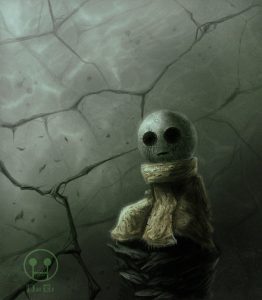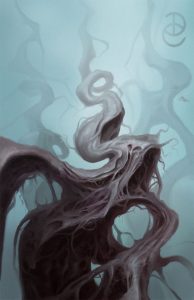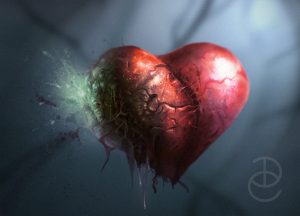
This month's Apex Magazine cover artist is Denis Corvus, whose art galleries are filled with visions of science fiction, fantasy, and horror. His piece for this month's cover combines all of that, and much more.
APEX MAGAZINE: Your cover piece for this month's Apex Magazine, “I Myself Wrote This Horror,” mixes innocence and curiosity with horror. How do you avoid one of these emotions, especially horror, from taking over your intentions for the piece?
DENIS CORVUS: I'm trying to keep the line between the dark arts and my personality. I really like dark, gloomy paintings, but my desire for peace must be positive. Though, there are moments, when I think about all sorts of things, for example about things happening in the world, about social problems, and problems of personality.
AM: Your fan art includes many characters and creatures from games, comics, and movies. As an artist myself, I have had fan art pieces become something different as I am working on them. Have there been any pieces of your art that started as fan art but became something else in the process?
DC: Yes, I like drawing fan art a lot and the main purpose here is to show the basic personal characteristics. But sometimes I want to change the character, add some new costume, change the design with my own elements or draw it in another setting, for example draw Batman in the Renaissance era. I often play different games and laughable characters interest me, and that's exactly where I get inspiration to draw fan art. I especially like villains.
AM: You have several pieces on your DeviantArt page, such as “On the other side of sleep” and “forgotten world of imagination,” that people have commented are creepy or scary. What do you think makes something creepy? Is it a character, a texture, even a use of color, or a mix of things?
DC: I think that's the total atmosphere of the painting. Accent on details is also important, as well as color and light. And textures, the root textures always seemed creepy to me, in a good sense, of course. I always liked drawing them. Cold and dark tones together with some rhythm can give a gloomy mood to any painting.
AM: Your piece, “heart rot,” is more abstract and less about characters, but still offers strong emotion. How do you bring emotion into an abstract piece, and how do you hope the viewer will interpret a piece like this?
DC: In this work, I wanted to show that every heart rots away in time, absorbing hate from the outside, especially to show it for people who keep accumulated anger inside themselves. I think that in some time such people become shameless and impartial to anything, and gradually change to sociopaths. People are born with a pure heart but circumstances and hard environment make them more evil.
AM: In your piece, “Unknown,” the skeletal remains of soldiers in their trench brings out an element of history. It reminds me of the war paintings of Vasily Vereshchagin, and his many paintings of the aftermath of war. What can art bring to history, especially the history of warfare? How important is art to remembering that history, or even avoiding repeating it?
DC: I think it's necessary to show the world, with all possible ways, that war brings nothing but destruction and suffering for both sides. Prime examples are events of the First and Second World Wars. I think paintings can show people that wars and disagreements destroy everything that humanity has been trying to create. I like different allegories on that theme, where war is represented in different forms. Also, I like paintings that show consequences of cruel battles.
Visit Corvus's galleries on DeviantArt to see more of his work, including his extensive galleries of game, anime, and film fan art pieces.













